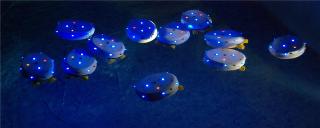May 30 2015
Scientists have created underwater robot swarms that function like schools of fish, exchanging information to monitor the environment, searching, maintaining, exploring and harvesting resources in underwater habitats.
 © COCORO
© COCORO
The EU supported COCORO project explored and developed collective cognition in autonomous robots in a rich set of 10 experimental demonstrators, which are shown in the 52 videos.
The COCORO project’s robot swarms not only look like schools of fish, they behave like them too. The project developed autonomous robots that interact with each other and exchange information, resulting in a cognitive system that is aware of its environment.
According to Dr. Thomas Schmickl, coordinator of the project and Associate Professor in the Department of Zoology at the University of Graz in Austria, what distinguishes COCORO from other similar projects is that researchers created robot swarms that are capable of collective cognition. They work as a collective system of autonomous agents that can learn from past experience and their environment.
Robot swarm cognition in action
In one experiment, twenty Jeff robots floated in a tank of water. As they came into contact with each other, they gradually became aware of the size of their swarm. This ‘swarm size awareness’ was made possible by relaying status information using LEDs.
In another scenario, the robots’ mission was to find debris originating from a sunken airplane. Lily robots searched just below the surface while Jeff robots searched at the bottom of the pool.
Magnets were placed around the airplane to mimic an electro-magnetic signal emitted locally and the robots used their built-in compasses to locate the target. A Jeff robot soon discovered the target and settled on it at the bottom of the pool.
By transmitting LED, it ‘recruited’ the other Jeff robots, which then gathered around the target, while Lily robots collected overhead.
During field trials in Livorno Harbour, Italy, the robots were exposed to waves, currents and corrosive salt water. Despite the difficult conditions the robot swarms were able to remain clustered around their base station as well as go on “patrols” and successfully return to base.
Bio-mimicry: inspired by nature
‘We didn’t invent all of this ourselves,’ says Dr. Schmickl, explaining that COCORO’s scientists modelled collective cognition in nature. Observing how honeybees cluster, for example, helped them to develop the BEECLUST algorithm that they used to aggregate robots at a specific location. They also applied mechanisms derived from existing studies on how slime mould amoebas congregate using chemical waves to communicate with each other.
A diverse group of biologists, computer scientists and other experts participated in COCORO, which ran from 1 April 2011 until 30 September 2014 and received EUR 2.9 million in EU funding.
Although the project concluded in 2014, its results could have wide application in the fields of computer science, biology, theology, meta-cognition, psychology, and philosophy, as well as a broader impact on our economy and society. Possible applications are in distributed environmental monitoring and search&rescue operations.
‘The way in which some swarm members influence others is very similar to how trends are set by opinion leaders in our society,’ notes Dr. Schmickl.
The COCORO project team has announced that 2015 will be the year of COCORO events. Every week they are presenting a new video made during the project, with the largest autonomous underwater swarm in the world with 41 robots of 3 different kinds.